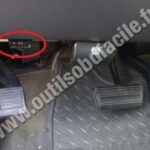Converting a vehicle from OBD1 (On-Board Diagnostics 1) to OBD2 (On-Board Diagnostics 2) is a complex undertaking that often sparks debate among car enthusiasts. While achieving a full conversion that replicates all OBD2 functionalities is highly challenging, various approaches offer different levels of compatibility and data access. This article delves into the intricacies of converting OBD1 to OBD2, exploring the possibilities, challenges, and alternative solutions.
Understanding the Differences: OBD1 vs. OBD2
Before diving into conversion methods, it’s crucial to understand the fundamental differences between OBD1 and OBD2 systems. OBD1, prevalent in vehicles manufactured before 1996, utilizes manufacturer-specific protocols and connectors, making data retrieval and diagnostics less standardized. OBD2, mandated in the US for 1996 and later models, introduced a standardized connector and communication protocol (SAE J1962), enabling universal diagnostic tools and broader data access. OBD2 also boasts more comprehensive monitoring capabilities, including real-time data for various engine parameters.
Converting OBD1 to OBD2: The Challenges
Converting an OBD1 system to a fully functional OBD2 equivalent involves significant hurdles. Key challenges include:
- ECU Compatibility: OBD2 requires a compatible Electronic Control Unit (ECU) that supports the standardized communication protocols. Swapping the original OBD1 ECU with an OBD2 counterpart from a similar engine model is often necessary but may require extensive rewiring and programming.
- Wiring Harness Modifications: Differences in sensor types, locations, and wiring configurations necessitate substantial modifications to the vehicle’s wiring harness. This process demands in-depth knowledge of both OBD1 and OBD2 wiring diagrams.
- Sensor Compatibility: OBD2 often relies on different sensor types and quantities compared to OBD1. This discrepancy may require adding new sensors, relocating existing ones, or modifying mounting points. For instance, a crankshaft position sensor might need upgrading from an 8-tooth to a 24-tooth configuration.
- Emissions Systems: OBD2 systems incorporate more stringent emissions monitoring, requiring components like catalytic converters, evaporative emission systems, and oxygen sensors that may be absent or different in OBD1 vehicles.
Alternative Solutions and Considerations
Given the complexities of a full conversion, exploring alternative solutions for accessing data from OBD1 vehicles is often more practical:
- Standalone Engine Management Systems: Aftermarket systems like Megasquirt (MS) offer advanced data logging and tuning capabilities, often surpassing OBD2 functionality. This approach bypasses the need for OBD2 conversion, providing a powerful solution for performance enthusiasts.
- OBD1 Scan Tools and Software: Utilize OBD1 specific diagnostic tools and software designed for your vehicle’s make and model. While less standardized than OBD2, these tools can still provide valuable diagnostic information.
- Arduino-Based Converters: DIY enthusiasts have developed Arduino-based projects that translate OBD1 data into a format readable by OBD2 software. These solutions require technical expertise and may not support all OBD2 functionalities.
- Data Acquisition Systems: For dedicated data logging, consider aftermarket data acquisition (DAQ) systems. These systems allow for granular monitoring of various vehicle parameters, offering a powerful alternative to OBD2 for track use.
Conclusion: Weighing the Options
Converting OBD1 to OBD2 is a daunting task with numerous challenges. While possible in certain scenarios with significant effort and expertise, alternative solutions like standalone engine management systems or dedicated OBD1 tools often provide more practical and cost-effective approaches for data access and diagnostics. Carefully consider your specific needs and resources before embarking on an OBD1 to OBD2 conversion. If comprehensive data logging and performance tuning are primary goals, exploring standalone systems might be the more rewarding path. For basic diagnostics and monitoring, utilizing OBD1 specific tools and software could suffice.

